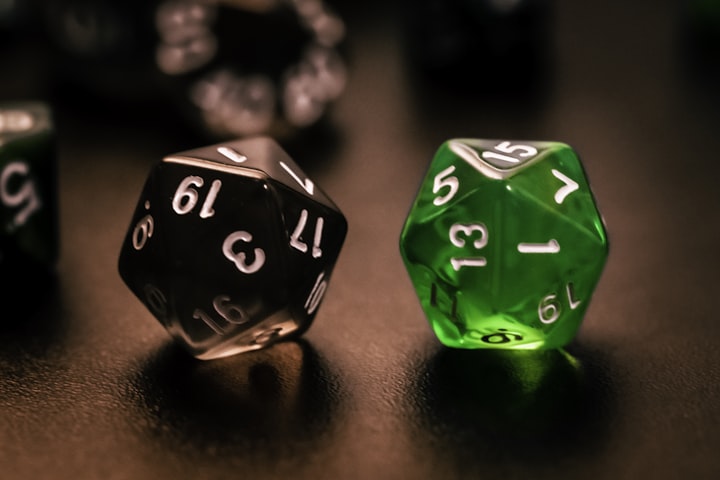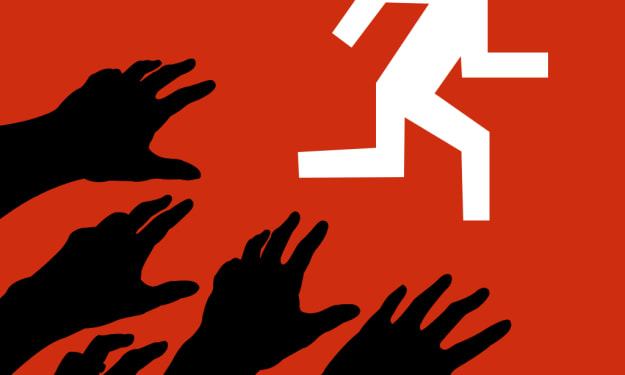A Dungeon Master Of Reality (Based Gaming)
Putting Your Skills to the Ultimate Test

What's This Now, Speak Up You Say?
Reality-based RPG games, also known sometimes as augmented reality (AR) games, have taken the gaming world by storm, transforming the way players interact with their surroundings. Combining narratives and virtual elements with real-world environments, these games offer an immersive experience that blurs the lines between fiction and reality. Beyond entertainment, reality-based RPG games are the ultimate challenge for players and Dungeon Masters. If you enjoy creating quests and/or multilayered storylines for people to play and figure out, this article is for you.
Imagine being able to take your ideas and use downtown, the neighborhood, or the local parks and recreation area as your map. Now imagine using all three in a grand quest for both single and multiplayer competitions. What better way to test your skills than to create an immersive challenge that everyone and anyone can play? In this article, we will look at the different components of creating a Reality-Based Game.
Whether you're a traditionalist and are ready to get the dwarfs and mages battling for the Trident of Chewings, or you want to try your hand at a deep murder mystery based in the 1920s. Sit back (or lean in, just remember it's bad for your back) and get ready to get your creativity going.
Before we begin, just one more thing. If you enjoy this article, don't forget to subscribe below. The Next Plan is always coming out with new content geared to inspire your next plan. From education to gaming, Photography to healthology, we're your huckleberry.
Let's dig in, we have a lot to do before sunrise.
What Manner of Beast Are You?

First, what kind of game experience do you want to create? Do you want to make it a time-limited, play-once kind of game? Do you want to limit it to teams or single players only? Or do you want to make it so your creation can be played by both, over and over if someone desires? It is very important to remember to keep a good measure of safety in mind, very important. How? Simple, assure you establish rules regarding safety and suggested times to play, but we will get to that later
This is up to you, however, the most challenging would be the latter, I would suspect. Creating a closed-ended reality-based RPG game in your community offers you a chance to build a base narrative and establish a world, general character, and backstory. By keeping it closed-ended, people will gain a sense of accomplishment. They will also be more likely to bring a group to play on a weekend or weekday night.
If you think you will be adding quests over time, creating your first Reality Based Game can be similar to creating the tutorial quests of video games. If you have a grand scheme of characters, storylines, and quests to fill a multitude of places, your want this first game to introduce players to the concept and narratives. Then, all your other quests are like expansion packs.
These quests usually last over some time, days weeks, and even months, and can usually be picked up where they were left off should the player have to go home and deal with kids. And if you are a kid, I meant to deal with par- no, nope, I meant to deal with kids. You guys are hard to deal with, man. Moving on.
If you think you just want to do a stand-alone mystery, creating your first Reality Based Game can be like creating the pen ultimate Dinner and a Murder activity. This still should be closed-ended as stated above, but you won't have to put as much detail into the characters and narrative (though, what the hell fun is that?). This style has its perks also, they can be time-limited or shorter allowing people to choose this activity for a day of entertainment.
Remember whichever you choose, it's not the storyline that matters at this point, it is the depth of immersion into the storyline, the amount of time you want people to spend, and if it is a standalone or introductory quest. That matters.
Special Tid Bit: Creating a Reality-Based Gaming Experience in your community that is open to the public, is a great way to show off your skills. any further quests or mysteries you create can be both public and private quests. If you aren't picking up what I am throwing down, monsieur, I'm saying it's a good way to advertise and attract people willing to pay you to make Reality Based Quests.
I'll Take That One, The One With the Weird Clucking Problem

To keep it simple, we're going to stick to creating a closed-ended quest. Unlike open-ended games that continue indefinitely, closed-ended games have a set duration and a clear objective. In this article, we will explore the step-by-step process of designing a closed-ended reality-based RPG game that multiple people can play together, turning your community into an interactive realm of adventure and excitement, or murder, blackmail, and gossip, kind of like high school.
Because you probably like games, I am going to leave the order of the steps up to you to decide. Well, except for inviting people to play your game, that has to be the last step. I mean it doesn't have to be, but, make sure you know people might call you, an idiot if you don't allow it to be the last step.
The actual reason for this (letting you put the steps in order, not the part about the idiot thing) is that I kept changing my mind on how it would work best. Doing similar activities, I have completed these steps in varying order, and I can not say one way is best.
Each Person Will Take Ten Paces... No, Redgie, That's a Cannon, You Can't Use That (The Steps, Get It?)

As I said, how you follow these steps will be up to you. One suggestion I do have is that you list each of these steps in a spreadsheet fashion, in a notebook to keep with you. If you are like me, you already have certain ideas of challenges, stories, and places. Use the notebook to write these ideas down to work with when you get to that step. Always finish a step to the best of your ability before moving on to the next step. Trust me, you will be doing a lot of rewrites. Doing it this way will give you some chance of not getting lost in the idea of the game so you can get everyone else lost in the game.
I do recommend that you start by defining the game's main objective and theme. Consider what you want players to achieve and what storyline or theme will drive the game's narrative. Choose a theme that resonates with your community and aligns with the values and interests of the participants.
Develop a Storyline and Quests
- Craft a captivating storyline that will guide players throughout the game. Divide the storyline into quests or missions that players must complete to progress. Each quest should be challenging yet achievable, encouraging players to collaborate and strategize. You definitely need to determine the duration of the game before you get too elaborate, so in this step keep it minimal, just a few words description to start.
Determine the Game Duration
- Closed-ended games have a defined duration, which adds a sense of urgency and excitement. Decide how long the game will run, whether it's a single-day event or a week-long adventure. The duration should allow sufficient time for players to complete quests and experience the game's narrative.
Add a Layer of Digital Fun
- Since the game is reality-based, incorporate augmented reality (AR) elements to immerse players in the virtual world. Use AR to create in-game landmarks, clues, or virtual characters that interact with the real-world environment. There are several AR apps out there to be used for free. These work wonderfully
- Remember to increase the amount of diverse players, less tech may be best. You can achieve the same effect with art, written clues, Geo Caches, etc. But then again, tech does appeal to targeted populations, so...
The Fun Part: Designing the Game Map
- Create a game map that outlines the boundaries of the game area. Ensure the map includes various locations where players will encounter quests and challenges. Consider both indoor and outdoor spaces to make the game accessible to all participants.
- Use your community public spaces. Involve active businesses. This is an opportunity for you to rub elbows, increase visibility, and free advertisement opportunities. Also, it will increase potential future customers if you should pursue doing this long term for money.
The Dungeon, The Dragons, The Little Mind Games (again, like high school)
- Design a variety of challenges and puzzles that players must solve to progress in the game. These challenges can range from physical tasks to brain teasers. Make the challenges engaging and aligned with the game's theme.
- Do not limit yourself and be as creative as you think you can be. Here is where you add your clues, your narrative movers, pictures, etc.
- Think inside the box. Make one of your rules a list of "equipment" players will need to play your game. Add to it a set of dice for chance-based obstacles. Keep it fun!! Mostly for you, but, then again, I guess players have to get something out of it, too.
Establish Rules and Guidelines
- Set clear rules and guidelines for gameplay to ensure fairness and safety. Define how players can earn points or rewards, how to resolve disputes, and any safety precautions to follow during the game.
- A good rule of thumb: keep activities limited to what is allowed in the public spaces you use. Put clues and extras in places people are permitted.
- DO NOT HIDE ANYTHING IN MABEL SMITH's ROSE GARDEN! Residentials are off-limits, even your own. Just trust me.
Create Teams or Alliances or Don't. I Don't Care.
- Encourage players to form teams or alliances to complete quests collaboratively. Teams can be based on neighborhoods, workplaces, or shared interests. This fosters a sense of community and teamwork throughout the game.
- Again, that is, if you decide your quest is for teams. If it is for single players, don't put in challenges that need two people to complete.
- If you are designing your quest for both single and multiplayer fun, you might consider creating two games with the same storyline and characters, keeping one largely open to NPC that you might have decided teams and group players must enact in their game.
Here Pigeon, Pigeon, Pigeon
- Establish a communication system for players to interact with each other and receive updates. Utilize messaging apps or social media platforms to facilitate real-time communication and share game-related information.
- Think about creating a social media page to keep vital info, rules, and updates of your own for people to like, share and subscribe to, much like you're going to do with our page, here at, The Next Plan, right?
Plan a Grand Finale and Space For Celebration
- As the game reaches its conclusion, plan a grand finale event where players come together to celebrate their achievements and unveil the resolution of the game's storyline. Reward participants for their efforts and contributions to the game.
Find Out What They're Complaining About
- Another good rule of thumb is to ask your friends, or somebody else's friends if you don't have any, to run through the quest before opening it up to the public. This gives you a chance to "break the game." Basically, it's your beta version.
- After the game concludes, gather feedback from participants to understand their experiences and suggestions for improvement. Use this feedback to refine future iterations of the game and make it an even more enjoyable experience for the community.
Role Credits

Designing a closed-ended reality-based RPG game for your community is a thrilling endeavor for you that brings people together and fosters a strong sense of community spirit while allowing you to shine. Through a well-crafted storyline, challenging quests, and augmented reality elements, participants embark on an adventure that blurs the lines between the virtual and real world.
As a bonus, you will be known as a fine community member for encouraging teamwork, communication, and problem-solving, the game creates lasting memories and strengthens social connections within the community, whether you really are one or not.
As you design and execute the game, remember that the ultimate goal is to create an inclusive, enjoyable, and immersive experience that leaves a positive impact on all participants and transforms your community into a realm of shared excitement and camaraderie. This way you get recognized for the genius you think you are.
Hey, thanks for reading, I hope this was worth your time. If so, why not throw a tip or Buy Me a Beer?
-D.J. Rees, The Next Plan, July 2023
About the Creator
The Next Plan
Just your everyday next thing on your list. Adding the next idea, the next gizmo, and the next everything else. Here to help you with all the next things you haven't thought of, Thanks for reading, The Next Plan






Comments
There are no comments for this story
Be the first to respond and start the conversation.